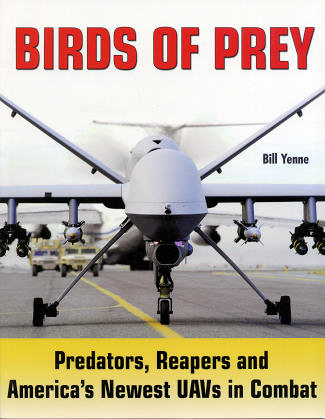Specialty Press'
Birds of Prey
|
Author: |
Bill Yenne |
|
Publisher |
Specialty Press |
|
Price |
$29.95 |
|
Reviewer: |
Scott Van Aken
|
|
Notes: |
160 pages, 8.5x11
inches, Softbound, 282 color photos,
ISBN: 978-1-58007-153-6 |
 To
paraphrase a quote from someone, "The future is here". By that, I mean that the
era of un-manned combat aircraft is upon us. It wasn't more than a few years ago
that we were saying 'Never happen' when it came to the discussion about UCAVs or
Unmanned Combat Air Vehicles. There acronyms are still flying in terms of what
to call these. Many of us think of them as drones as that is what we have grown
up with.
To
paraphrase a quote from someone, "The future is here". By that, I mean that the
era of un-manned combat aircraft is upon us. It wasn't more than a few years ago
that we were saying 'Never happen' when it came to the discussion about UCAVs or
Unmanned Combat Air Vehicles. There acronyms are still flying in terms of what
to call these. Many of us think of them as drones as that is what we have grown
up with.
A drone is basically a radio controlled
aircraft. Initially these were set on a predetermined course to be used as a
target for anti-aircraft gunners. Later, some rudimentary abilities to be flown
from the ground was added and things just took off. The USAF and USN both
developed full scale targets equipped with cameras and a full array of flight
instruments so that out of service tactical jets could be operated much as if
there was a pilot and allow the target to be maneuvered. This would provide an
even more realistic engagement experience for the attacking pilot. While the
Navy has given up on this, the USAF still flies old Phantom IIs to be used as
expendable targets out of Tyndall and Holloman AFB.
But now, things have changed. Starting out as
simple reconnaissance platforms, the current batch of drones or UAVs allow
battle field commanders to have real time photo recon of an area of interest
that would otherwise be rather hazardous flying for a manned aircraft. Ranging
in size from planes no larger than a good size R/C aircraft to the huge Global
Hawk, able to stay in the air for many, many hours and fly at vary high
altitudes, they are now redefining aerial recon and in many ways, making manned
recon obsolete.
Of course, it didn't take long to figure out
that with some of these, you could hook up an air to ground missile (like the
Hellfire) and actually use it in offensive operations. This is what happened to
the RQ-1 (now MQ-1) Predator. Originally put in service as a recon platform, it
is now, in conjunction with the larger and more capable MQ-9 Predator, a major
strike aircraft in both Iraq and Afghanistan. Two things make these aircraft so
valuable. One is that they can stay on station for 18-24 hours. Few pilots can
remain that alert for so long and though manned aircraft can stay in the air
through air to air refueling, the UCAVs don't have to refuel. Secondly,
these aircraft are somewhat quiet so the bad guys are often not aware they are
there until the missiles are hitting around them.
Thanks to these two traits, the target group
in Afghanistan and Pakistan is slowly being eliminated or kept in even closer
hiding. It is amazing to think that these aircraft are flown by operators
sitting in air conditioned spaces near Las Vegas, Nevada.
In this book on these vehicles, author Bill
Yenne tells the full history of unmanned aviation from the old biplane Kettering
Bugs of 1918 through the various Radioplane target aircraft of WWII, the Ryan
Firebees of Vietnam and up to the current and future crop of aircraft. The USAF
is very much buying into the program, with not only a full wing of four
squadrons based in Nevada, and a squadron at Beale, but also several ANG units,
who have turned in their KC-135s, F-16s and other aircraft for unmanned planes.
Most of the book is on the development and
operations of the Predator, Reaper and Global Hawk, which are proving to be
extremely useful and capable platforms. It is a book that I have to say exceeded
my initial expectations by quite a bit. It is interesting, timely and a book
that I fully believe every aviation enthusiast should read.
As Bob Dylan said "The times they are
a'changin".
September 2010
Review book courtesy of
 ,
where you can order your copy of this and many other superb aviation and
modeling books.
,
where you can order your copy of this and many other superb aviation and
modeling books.
If you would like your product reviewed fairly and quickly, please contact
me or see other details in the Note to
Contributors.
 To
paraphrase a quote from someone, "The future is here". By that, I mean that the
era of un-manned combat aircraft is upon us. It wasn't more than a few years ago
that we were saying 'Never happen' when it came to the discussion about UCAVs or
Unmanned Combat Air Vehicles. There acronyms are still flying in terms of what
to call these. Many of us think of them as drones as that is what we have grown
up with.
To
paraphrase a quote from someone, "The future is here". By that, I mean that the
era of un-manned combat aircraft is upon us. It wasn't more than a few years ago
that we were saying 'Never happen' when it came to the discussion about UCAVs or
Unmanned Combat Air Vehicles. There acronyms are still flying in terms of what
to call these. Many of us think of them as drones as that is what we have grown
up with.